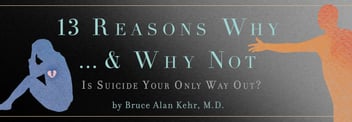Navigating the Storm: Preventing Teen and Young Adult Suicide
- Home
- Blog

Dear Concerned Parents, Educators, and Counselors,
In our journey to safeguard the mental health of our youth, understanding and preventing suicide among teenagers and young adults is paramount. The rise in suicide rates in this age group calls for a compassionate, informed response from all of us. This blog aims to guide you in recognizing warning signs and taking proactive steps to protect the young minds in your care.
Understanding the Silent Crisis
Suicide is a silent crisis that often goes unnoticed until it's too late. As the third leading cause of death among 15–24-year-olds, it's a critical issue that demands our attention. A combination of factors, including untreated depression, societal pressures, and the challenges of adolescence and young adulthood, can lead to suicidal thoughts.
Recognizing the Signs: Early Intervention is Key
The journey to prevention begins with vigilance. Look for signs of withdrawal, mood changes, or a decline in academic performance. These subtle shifts in behavior can be the first indicators of a deeper struggle. Symptoms like insomnia, crying spells, or a sudden disinterest in previously enjoyed activities should raise your concern.
Effective Communication: The Bridge to Understanding
Engaging in open, empathetic dialogue is crucial. Approach the young person in your life with genuine curiosity and compassion. Asking questions like, “How are you really feeling?” can pave the way for honest conversations. Remember, it's not about fixing their problems immediately, but about showing that you are there, willing to listen and support.
The Four E's of Suicide Prevention
- Evaluate: Observe behavioral changes and gather information from various sources, including school officials or friends, to get a holistic view of the young person's well-being.
- Empathize: Put yourself in their shoes. Recalling your own teenage challenges can help you connect with their experiences more authentically.
- Enlist Help: Don't hesitate to seek professional help. Early intervention with a qualified therapist can be lifesaving.
- Emancipate and Communicate: Encourage independence while maintaining open lines of communication. Trust, but verify, especially when they're away from home.
Creating a Supportive Environment
Fostering a supportive environment is essential. This includes being a consistent presence in their lives, offering unconditional love, and reminding them of their worth and potential. Encourage activities that promote mental wellness, such as mindfulness, exercise, or creative hobbies.
Digital Awareness: Understanding the Online Influence
In today's digital age, be mindful of the impact of social media and online content. Shows like "13 Reasons Why" and movies like “Dead Poets Society” and “Cyberbully” can initiate important conversations, but also require careful handling to prevent negative influences.
Collaborative Effort for a Safer Future
Preventing teen and young adult suicide is a collaborative effort. It requires the involvement of parents, educators, and mental health professionals. By staying informed, creating open channels of communication, and fostering a nurturing environment, we can help navigate our youth through these turbulent years.
Seeking Professional Guidance
For those facing challenges in addressing this sensitive topic, resources like my book, “Heal an Existential Crisis in a Young Adult,” offer deeper insights and practical tools. Additionally, visiting my three part blog series on Cyberbullying provides valuable information on handling bullying, PTSD, and depression.
Conclusion: A Collective Responsibility
In conclusion, the task of preventing suicide in teenagers and young adults is a collective responsibility. By being vigilant, compassionate, and proactive, we can make a significant difference in their lives. Let's commit to being the guiding light in their journey, helping them see the hope and possibilities that lie ahead.
To learn more about mental health and wellness, and to stay updated with practical insights, visit https://www.potomacpsychiatry.com/blog and consider subscribing to future blogs.
.png?width=144&height=144&name=Untitled%20design%20(34).png)



